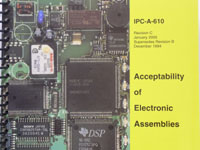Blog Archives
IPC Class 3
Just what is IPC Class III and why should you care? IPC-A-610 covers workmanship for electronic assemblies – the boards you design and get built up. The higher the number, the more stringent the build and inspection requirements are. Class II is the general commercial standard: items produced and inspected to IPC-A-610 Class II are deemed quality for typical commercial applications. Class III are deemed to be appropriate for hi-reliability and mission critical applications.
For most prototype and small volume applications, IPC Class II workmanship and inspection will be just fine. However, for some with tighter reliability requirements, e.g. aerospace, military, medical, harsh environments, class III workmanship and inspection may be required.
Class 3 products demand continued high performance or performance-on-demand is critical and equipment downtime cannot be tolerated, the end use environment may be uncommonly harsh, and the equipment must function when required, such as life support or other critical systems.
By reviewing the requirements of Class 3, within the IPC documents the differences are found in component placement for surface mount components, hole fill requirements for plated through holes, cleanliness requirements based upon residual contaminants on the surface of the product, plating thicknesses as defined in plated through holes and on the surfaces of printed circuit boards.
Although there are many other differences, these are ones which come to mind quickly. These individual issues can impact the performance requirements of Class 3 product, hindering their ability to function on demand.
A couple of examples that come to mind are a pacemaker, which has to work immediately and down time cannot be tolerated or a rocket on the wing of an aircraft has to fire when activated and its downtime cannot be tolerated.
IPC-a-610e
The IPC-A-610E, Acceptability of Electronic Assemblies is the most widely used specification published by the IPC for the electronics manufacturing industry. This publication is a visual document that provides comprehensive accept/reject criteria for handling of electronic assemblies, mechanical assemblies, component installation, location, orientation, soldering, cleanliness of assemblies, marking of assemblies, coatings, laminate conditions, discrete wiring assembly and surface mount assemblies.
Worker Proficiency students will be evaluated on their mastery of the IPC-A-610E material through end-of-course tests that have both open-book and closed-book components. Students must receive an average of at least 70% on both tests. Upon satisfactory completion of the course, participants will receive an IPC certification that is valid for 24 months . Everyone who successfully completes the worker proficiency certification will receive a copy of the IPC-A-610E Acceptability of Electronic Assemblies.
This class does NOT include any hand soldering instruction. Please see the Assembly classes for hand solder training.
Topics Include:
- Terms and Definitions
- Handling Electronic Assemblies
- Mechanical Assemblies
- Component Installation Location/Orientation
- Soldering
- Cleanliness
- Marking and Coatings
- Laminate Conditions
- Discrete Wiring Assembly
- Surface Mount Assemblies
This is a 3-day, lecture only course that teaches students the accept/reject criteria in the IPC-A-610, for all three classes of PCB assembly. Everyone who successfully completes the Worker Proficiency certification and examination will receive an IPC-A-610, IPC-A-610 Worker Proficiency Handbook and an IPC Certificate of Training.
Please visit BEST Inc. at
http://www.solder.net/training/courses/IPC-A-610-CIS_description.asp
for more information.
IPC A-610 Training
The number one IPC certification program for good reason is the IPC A-610. This is for good reason. This definitive standard is at the end of the manufacturing food chain impacting the quality, procurement, process, inspection, end customer inspection and assembly groups greatly.
The training and certification training is based on the IPC A-610 industry consensus standards which define the acceptability criteria for finished and final assembled PWBs. It is used as a referee guidebook when OEMs are discussing with either their contract manufacturers or internal assembly group about what is acceptable and what is a reject.
In IPC jargon there exist 2 training program levels……CIS and CIT. CIS, or technician level certification is for floor personal including but not limited to QC inspectors, leads for test of manufacturing, engineering personnel. Sometimes management and personnel get in to the act as well. At the CIT level these are the people who will be instructing those who are CIS certified.
The certifications are based on knowing how to use the and look up and interpret what is found in the industry consensus document, the IPCA-610. the certifications are valid for 2 years and are transferable with you, as they belong to you individually.
Classes for the CIS level are structured so that they are modularized to fit those who manufacture nearly every conceivable electronics assembly all the way to those dealing with just wire harness and cable manufacturing. They are modularized where some of the modules are mandatory while others are suitable to a given business and therefore are only taught when required. If all the modules are taught the complete class is taught in 3 days.
By the way make sure you are being instructed to the latest revision level (see your contract wordings) as the “E” revision was recently launched in the summer of 2010.
